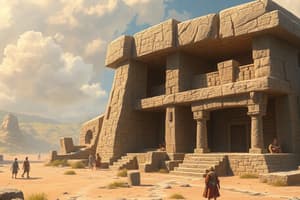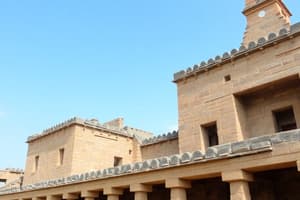Podcast
Questions and Answers
What architectural feature appears to have been used for lighting in the Near East temples?
What architectural feature appears to have been used for lighting in the Near East temples?
- Skylights
- Large windows
- Glass panels
- Clerestory (correct)
How were the roofs of the Near Eastern palaces typically constructed?
How were the roofs of the Near Eastern palaces typically constructed?
- Steel beams and concrete
- Timber beams and clay (correct)
- Stone slabs and timber
- Thatched roofing
Which type of capitals were found in the columns of the later period at Persepolis?
Which type of capitals were found in the columns of the later period at Persepolis?
- Single-flower capital
- Minimalistic capital
- Double-bull capital (correct)
- Simple cylindrical capital
What material was prominently used for roofing in Assyrian palaces?
What material was prominently used for roofing in Assyrian palaces?
What decorative feature was specified in the mouldings of Persepolis?
What decorative feature was specified in the mouldings of Persepolis?
What is the primary aim of architecture?
What is the primary aim of architecture?
Which of the following influences is NOT considered a factor in the development of architecture?
Which of the following influences is NOT considered a factor in the development of architecture?
What architectural style is characterized by the use of large stones and an interlocking system?
What architectural style is characterized by the use of large stones and an interlocking system?
Which stage of human development saw the transition from nomadic life to agriculture?
Which stage of human development saw the transition from nomadic life to agriculture?
Which statement best describes architecture as a social act?
Which statement best describes architecture as a social act?
What is the significance of the term 'Arki-tekton' in architecture?
What is the significance of the term 'Arki-tekton' in architecture?
Which type of tomb was developed during the Middle Kingdom by Mentuhotep II?
Which type of tomb was developed during the Middle Kingdom by Mentuhotep II?
Which Pharaoh is recognized for erecting the earliest known obelisk at Heliopolis?
Which Pharaoh is recognized for erecting the earliest known obelisk at Heliopolis?
What is one of the earliest cultural practices related to architecture noted in prehistoric times?
What is one of the earliest cultural practices related to architecture noted in prehistoric times?
Which stage of architecture follows the Romanesque style in the historical timeline?
Which stage of architecture follows the Romanesque style in the historical timeline?
What architectural feature is characterized by its inclination from base to top?
What architectural feature is characterized by its inclination from base to top?
Which type of architecture primarily emphasizes the characteristics of a specific region or time?
Which type of architecture primarily emphasizes the characteristics of a specific region or time?
Which period is marked by the construction of the Great Hypostyle Hall in Karnak?
Which period is marked by the construction of the Great Hypostyle Hall in Karnak?
What does the chronological narrative of significant architectural events help to explain?
What does the chronological narrative of significant architectural events help to explain?
Who created the funerary temple at Mt. Deir el Bahari, known for her significant architectural contributions?
Who created the funerary temple at Mt. Deir el Bahari, known for her significant architectural contributions?
What is a mastaba?
What is a mastaba?
What architectural feature is characteristic of Assyrian and Babylonian structures?
What architectural feature is characteristic of Assyrian and Babylonian structures?
What does the term 'serdab' refer to in the context of an Egyptian tomb?
What does the term 'serdab' refer to in the context of an Egyptian tomb?
What are the prominent characteristics of ziggurats?
What are the prominent characteristics of ziggurats?
What inspired the moulding designs in Egyptian architecture?
What inspired the moulding designs in Egyptian architecture?
Which is NOT a part of a pyramid complex?
Which is NOT a part of a pyramid complex?
Which feature is commonly found atop a ziggurat?
Which feature is commonly found atop a ziggurat?
Which structure is identified as a representative development during the Assyrian period?
Which structure is identified as a representative development during the Assyrian period?
How was the construction of the pyramids achieved?
How was the construction of the pyramids achieved?
What type of tomb is characterized by being a sealed burial chamber beneath a rectangular mound?
What type of tomb is characterized by being a sealed burial chamber beneath a rectangular mound?
What was significant about the Palace of Sargon in Khorsabad?
What was significant about the Palace of Sargon in Khorsabad?
What adornments were commonly used in Assyrian and Babylonian architecture?
What adornments were commonly used in Assyrian and Babylonian architecture?
Which pyramid is known as the oldest surviving masonry building structure in the world?
Which pyramid is known as the oldest surviving masonry building structure in the world?
What architectural style is typical of Persian structures?
What architectural style is typical of Persian structures?
Which of the following describes a true pyramid?
Which of the following describes a true pyramid?
What was the primary purpose of ziggurats besides serving as temples?
What was the primary purpose of ziggurats besides serving as temples?
How were the angles of ziggurats constructed in relation to the cardinal points?
How were the angles of ziggurats constructed in relation to the cardinal points?
Which of the following describes the architectural character of Near Eastern styles?
Which of the following describes the architectural character of Near Eastern styles?
Flashcards are hidden until you start studying
Study Notes
Prehistoric Architecture
- Before 9000 BC, humans were nomadic hunters and gatherers.
- The development of tools (made of stone, wood, and bone) contributed to human success.
- Around 9000 BC, farming and agriculture became prevalent due to fertile soil and plentiful food.
- Prehistoric people lacked organized religion but showed respect for the dead through burial rites and monument construction.
Near East Architecture
- Near Eastern architecture features massiveness, monumentality, and grandeur.
- The Assyrians and Babylonians employed an arcuated construction style, using arches, vaults, flat strips, and buttresses adorned with glazed tiles.
- The Assyrians and Babylonians incorporated colossal winged bulls, carved alabaster slabs, and sculptured bas-reliefs into their architectural designs.
- The Persians favored columnar and trabeated construction with flat timber roofs, sometimes incorporating domes.
Babylonian Architecture
- Ziggurats, or "Holy Mountains," were the most prominent structures in Babylonian architecture.
- Ziggurats were square or rectangular in plan with steeply battered sides, culminating in an open platform on top that housed the "Fire Altar."
- The angles of these temples faced the cardinal points.
- Ziggurats were surmounted with richly decorated temple chambers, functioning as shrines and observatories for astrological studies.
- Ziggurats evolved from single-stage structures to seven-stage structures during the Assyrian period.
- The White Temple, located in Warka, is an example an archaic ziggurat, featuring a single flat-topped rectangular mound supporting the upper temple.
- The Ziggurat in Nimrod is an example of a two or three- staged ziggurat, with a rectangular plan and multiple tiers or stages.
- The Ziggurat in Ur is another example of a two or three-staged ziggurat, with a rectangular plan and multiple tiers or stages.
Assyrian Architecture
- The Palace of Sargon, located in Khorsabad, is an example of an Assyrian palace.
- The entrance portals of the palace were flanked by statues of headed winged bulls and lions.
- The Palace at Khorsabad contained 700 rooms and occupied a vast area of 25 acres.
Near East Architectural Comparisons
- Lighting for Near East temples was likely achieved through clerestory windows.
- The Near East utilized both circular and pointed arches.
- Doorways were large, providing ample light and air to the buildings, and openings were also constructed in the upper portion of the walls.
- Timber beams spanning between columns, resting on double-bull capitals, provided roof support.
- Palace halls were covered by brick tunnel vaults, while flat roofs, constructed from tough clay and debris, provided additional roof construction.
- Columns, primarily made of wood, were eventually constructed from natural stone in Persepolis.
- Capital types included double-bull, double-unicorn, double-horse, and double-griffin, along with the Ionic scroll motif.
- Assyrian palaces were adorned with sculptured slabs and colorful surfaces.
- Mouldings employed in Persepolis included beads, hollows, ogees in the bases, while volutes of the capital were treated with plain sinkings.
Egyptian Architecture
- Egyptian Architecture is characterized by simplicity, monumentality, and solidity or massiveness.
Egyptian Architectural Features
- Battered walls — an inclination from the base to the top of the façade.
- Hieroglyphics — used as ornaments, pictures, and writings on the walls.
- Decorations — Mouldings like "gorge" or "hollow and roll" were inspired by reeds. The torus moulding was also used.
- System of construction:
- Post and lintel
- Columnar or trabeated
Egyptian Tombs
- There were three main types of tombs:
- Mastabas
- Royal pyramids
- Rock-hewn tombs
Egyptian Mastaba Tombs
- The mastaba was the earliest type of Egyptian tomb.
- These structures were designed to house a body at full length.
- They are flat-topped funerary mounds, rectangular in shape, with battered sides (angled at 75 degrees) covering a burial chamber beneath the ground.
Mastaba Parts
- Outer chamber
- Serdab: an inner chamber containing stelae (stone inscribed with the deceased's name), a statue of the deceased, and an offering table.
- Chamber containing the sarcophagus, accessible through an underground shaft.
The Mastaba at Saqqara
- The Mastaba at Saqqara is an example of a Mastaba tomb.
Egyptian Royal Pyramids
- Royal pyramids are massive funerary structures made of stone or brick.
- They feature a square plan with four sloping triangular sides meeting at the apex.
-
Pyramids evolved from Mastaba tombs. - The four sides of a pyramid are aligned to face the cardinal points.
- Construction of a pyramid required the labor of 100,000 men over a period of 100 years.
Egyptian Pyramid Types
- Stepped Pyramid: The Pyramid of King Zoser (or Iser) — a stepped pyramid built by Imhotep, the oldest surviving masonry building structure in the world.
- Bent/Blunt/False Pyramid: The Pyramid of Seneferu.
- Slope or True Pyramid: The Pyramids of Giza: - The four sides of the pyramids of Giza face the cardinal points and are nearly equilateral triangles. - The Great Sphinx, a man-lion statue, stands as a protector of the country, representing King Chepren.
Parts of a Pyramid Complex
- Elevated Causeway.
- Offering Chapel.
- Mortuary.
- Valley Building.
Studying That Suits You
Use AI to generate personalized quizzes and flashcards to suit your learning preferences.




